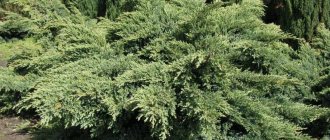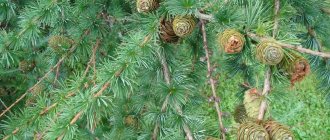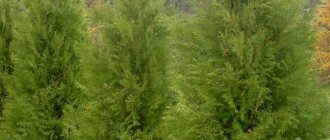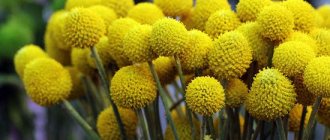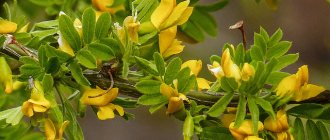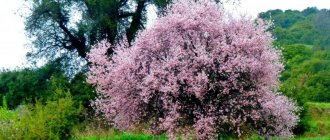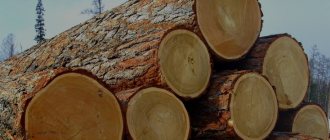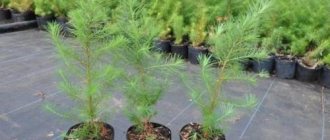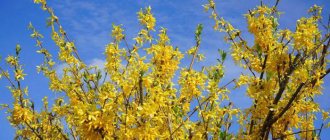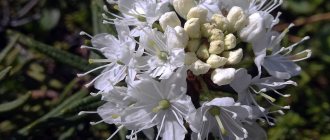Since ancient times, gardeners involved in arranging their home plots have been attracted to coniferous plants. But most often, lovers of coniferous beauties focus their attention on larch, a coniferous tree with excellent characteristics. This amazing plant predominates in the northern hemisphere of planet Earth and is highly frost-resistant.
Since time immemorial, strong and durable larch trunks have been used in the construction industry, the bark has been processed for paints and tanning, and oil has been squeezed out of soft needles. At the present stage, the plant is used in landscape design in parks of stone cities and summer cottages.
Methods for propagating larch at home
Larch is unique and completely unpretentious to climatic conditions. It has good resistance to low temperatures in winter and high temperatures in summer, and feels great in the concrete jungle. The plant, which is not picky about soil composition, requires good lighting. Green spaces, widely found in European countries, have gained popularity in our country. Domestic gardeners gave particular preference to the Siberian variety of the plant. For those who are planning to acquire this miracle at their summer cottage, let's talk about ways to reproduce it.
Larch propagation by cuttings
Propagation of larch seems possible by two methods - growing a sprout from seeds, or propagating planting material by cuttings. The easiest and most effective method is propagation by larch cuttings. First you need to cut rods approximately 12 cm long.
You should focus on the workpiece material. Cuttings should be cut from healthy branches, as they subsequently take root poorly and will grow very slowly. When rooting larch branches into the ground, to preserve juice and nutrients, it is time to make a small cut in the bark, from which roots will subsequently grow.
After the roots appear on the branches, the planting material should be moved to the soil substrate in the open ground, and it is important to take into account the requirements for planting - maximum lighting and drainage, which saves the tree from stagnant moisture. The advantage of propagating coniferous trees by cuttings is the possibility of planting the cuttings immediately in open soil. Further care for young animals comes down to moderate watering. In the same way, young shoots can be grafted onto already grown shrubby larches.
Propagation of larch by seeds
Many gardeners wonder how to grow larch from collected seeds. The entire propagation process is, of course, labor-intensive, but the result will certainly please you with the young shoots of this amazing coniferous beauty. So, in order to grow larch from a cone, you need to collect the material required for the work - the cones themselves.
Collection and preparation for planting seeds
When wondering how to grow larch from seeds, it is important to initially study the entire process of larch propagation by seeds from beginning to end. In order to plant an evergreen beauty tree in your yard yourself, you should obtain seeds from its cones. At the end of October, it is best to collect the material necessary for work. Only those cones whose scales are tightly pressed to each other are selected. The cones are placed in a warm place to open them completely. After the seeds are removed from the scales, it is time for stratification. Guaranteed germination and rapid germination are possible only after it has been carried out.
The prepared seeds are placed on a plate in the refrigerator on the bottom shelf. A prerequisite for stratification is control of the temperature range, since high temperatures will cause seeds to grow earlier than required.
Collecting seeds
To get seeds, you need to collect cones from wild trees or larches growing in nearby gardens and parks. Usually they ripen at the end of August - beginning of September, but open only in December. However, there is no need to wait for this at all. In addition, birds are quite active in pecking at seeds, therefore, in order to get the best seedlings, it is better to collect them before the beginning of winter. Only young cones (their seeds have a lighter shade) with tightly compressed scales should be collected.
Sowing seeds of a coniferous beauty
Propagating larch from seeds at home will not take much free time and effort. To do this you need:
- planting material (sprouted seeds);
- sand;
- peat;
- sawdust;
- crushed chalk;
- small container size;
- drainage (broken bricks, pebbles and others);
- agrofibre.
Having decided on the tanks for planting, it is worth preparing the soil itself for the larch. For this, a special mixture is prepared: 3 kg of sand and 40 g of crushed chalk are added to 10 kg of peat. The bottom of the selected vessel is lined with pebbles or expanded clay to create drainage.
Then the container is filled with the prepared composition and moistened. Holes no more than 1.5 cm deep are made in the soil and a seed is placed. After planting the seeds in the soil mixture, the whole thing is covered with a layer of peat and sawdust.
Then, for effective growth, the seeds need to create a greenhouse effect - place the container in a warm place and cover it with agrofibre. At home, you can use glass or ordinary film.
The entire process of seed germination should be sprayed with water and destroy pathogenic microbes. When the seedlings first sprouted, it is necessary to provide the maximum amount of light to the sprouts and remove agrofibre.
Many amateur gardeners are concerned not only with how to plant larch, but also with how to protect it from disease. Gardeners share the answer to these questions and advise systematically treating seedlings with fungicidal compounds. Larches are extremely susceptible to fungal diseases, and therefore require maximum protection in non-specialized conditions. Before planting, the seeds are kept in hydrogen peroxide for some time. This procedure reduces the likelihood of fungal disease in seedlings to a minimum.
How to choose a site for larch
Take this with great responsibility, because this coniferous tree cannot grow normally in the shade. It needs a sunny area.
Note! Of the twenty species of larch, only one can grow in the shade - this is the Japanese species.
It could also be this: you have long dreamed of growing larch on your plot, but there is no room left for it in your dacha. What to do? You can plant a small copy of it in your garden bed. This is done by pruning. It is good that this coniferous tree tolerates this procedure without problems and quickly returns to normal after it. It is for this reason that before planting larch in the garden, you should familiarize yourself with the basic techniques for cutting it. It is quite possible that your knowledge of the art of bonsai will come in handy. You should also not refuse to grow ornamental larch species on your site.
Growing seedlings in open ground
Young coniferous trees react rather poorly to replanting, especially those with an exposed root system. Seedlings more than 2 years old should be replanted only with a large earthen lump on the roots. Speaking about planting young plants sown in special containers, it is necessary, if possible, to carefully cut the container without damaging the root system and soil around them. Such a transplant of young animals will be the most gentle.
It is necessary to propagate larch in the fall or at the very beginning of spring. During this period, the soil contains a minimum number of pathogens, which makes it possible to exclude infection of the root system.
Mycorrhiza, a form of close relationship between roots and fungi that assist the plant in the absorption of minerals, is an important individuality of the larch root system. Therefore, when propagating seedlings or mature trees, it is very important to add soil from some other coniferous plants (fir, spruce, pine) to the planting hole.
Buying a larch seedling
There are two ways to grow larch: seedlings and seeds. The simplest one is seedlings. Their age should be approximately 3-4 years. It is better to buy plants in special containers, since you can plant larch along with the soil in which it grew. Thus, the seedling will take root much faster and better. Pay special attention to the tips of the needles; they should not be damp. Also look at the branches, they should bend.
Note! When you decide to buy larch, do not go to expensive and popular supermarkets, but to simple garden nurseries, where you are more likely to buy a healthy and strong tree.
But it is not always easy to buy larch. It’s just that a seedling cannot be found in every garden store. That is why you can take not a seedling, but seeds for planting. They are collected with their own hands from cones in the fall or bought in special stores.
Until they are planted in the ground, the seeds are stored in paper. They retain germination for about 3 years.
Temperature
Before propagating larch in your summer cottage, it is important to decide on the variety of coniferous miracle with soft needles and its characteristics. Not all varieties have good frost resistance. For example, you can take Japanese larch. All species that were bred at the beginning have low frost resistance and in the winter months the plant must be covered with agrofibre.
When engaged in propagation, it is preferable to choose types of larch, planting and caring for which will cause the least amount of trouble: Siberian, American, European or Gmelina. These species are highly frost-resistant and can easily tolerate frosts as low as -30 degrees, without the need for agrofibre.
Types and varieties of larch
What is the difference? As you probably already understood, the appearance of the cones)) But not only. So, let’s say, the “conifer fall” of the Gmelin larch ends in the 2nd half of October, while the Siberian larch and American larch shed their golden needles only in November.
Gmelin larch looks like :
European larch is quite common in Russia.
Tamarack:
Japanese larch:
Within each species there are hundreds of subspecies and new varieties. You can't list everything. The last thing I would like to say.
Substrate
Uncultivated larches are absolutely unpretentious to the composition and structure of the soil. They grow well in highly acidic and alkaline soils. But this only applies to wild trees.
Planting material that is propagated indoors is very delicate and may simply not survive in such soil. To avoid this, special soil is prepared for larch. When planting in open soil, drainage made of expanded clay or pebbles is initially installed at the bottom of the hole. Seedlings are sensitive to excess water and may die. Reproduction of young animals and good development is possible when grown in loamy substrates with medium or weak acidity and good oxygen saturation.
Seed preparation
At home, the cones should be placed in a linen bag and placed in a warm place for several days (for example, near a radiator). After they open, we separate the seeds from the shell and select those suitable for planting. This procedure is called calibration and is performed as follows: the seeds are placed in a container of water and left for 2 days. Good and germinating grains will sink to the bottom, and empty and unusable grains will remain on the surface.
Having selected suitable seed material, keep it in a solution of potassium permanganate or hydrogen peroxide for about half an hour.
Caring for larch seedlings
Reasonable care for larch is required for it to grow and develop properly. When planting larch in the fall, it is very important to follow the following instructions:
- Lighting. In the first quarter of the seedlings' life, there should be no direct sunlight. The most optimal place in the house for seedlings can be called window sills located on the western and eastern sides.
- Temperature. The room in which the boxes with seedlings are located must be heated to 20 degrees. In the summer months, young animals are artificially shaded to protect them from sunlight. For wintering, it is better to place the seedlings on a warm, glassed-in loggia.
- Watering. Planting larch is possible in places far from moisture, since excess moisture can lead to the death of the tree. Watering the tree is repeated after each drying of the top layer of soil. In addition, infrequent spraying of the larch crown would be encouraged.
- Loosening. In order to prevent moisture from collecting in the soil, the soil around the plant is loosened after the next watering.
- Feeding. At the first formation of needles on a young tree, the first fertilizer is applied. Nitrogen-containing fertilizers promote active growth of green mass on the tree.
- Crown trimming. Maintaining a decorative appearance, forming a crown and preventing excessive thickening of plantings is determined by pruning the tree.
There are three types of larch pruning:
- Sanitary. It is carried out in cases of tree disease or damage by various pests. Pruning involves removing all dead branches and branches affected by mold and moss. If not properly cared for, a burl appears on the bark, which should also be removed.
- Rejuvenating. Pruning is carried out in early spring or autumn. One third of the old shoots and weak branches are removed from the trunk. Rejuvenating pruning allows you to restore the decorative appearance of even the oldest trees.
- Formative. Pruning is carried out on young seedlings and allows them to form the shape of a coniferous miracle. Time for pruning: early spring.
Pruning of the majestic beauty should be done with sharp pruning shears, which are disinfected before each use. Autumn pruning is carried out strictly after the branches have completely shed their needles. In August, you should fertilize with complex mineral fertilizers, which are intended only for coniferous plants.
How to care for larch
When grown, this coniferous plant does not require much care. It consists of the same rules as with other plants: water the tree, loosen the soil and get rid of weeds around the tree trunk.
Larch does not tolerate drought. Therefore, be sure to water it. This is especially true for young plants (up to about two years old). One adult tree needs to be poured with about 20 liters of water 2 times in 7 days.
Note! Many gardeners recommend watering the larch tree with water that was used to wash mushrooms. This makes the tree grow much faster and become stronger.
Loosening and weeding are necessary only for young trees. Adult larches can do without these activities. If you want to give the plant a more sophisticated or unusual look, you can try pruning it. Just also remember that pruning can only be done on young trees.
Larch from seedling
Planting material should be purchased in specialized stores. The age of seedlings should not be more than two to four years. When choosing a plant, the priority should be the material planted in a plastic container, and the tree itself should have a healthy appearance: have stiff branches and green needles without dried tips.
Transplantation of young animals from a container into the ground is carried out in autumn or early spring. Before planting a seedling, prepare a planting hole with a minimum size of 50*50 (the hole should be twice as large as the container with the seedling). To ensure that the root system remains intact, the plant is transplanted into a hole with all the soil from the container. The seedling is buried in a hole to the root collar and covered with a pre-prepared mixture of peat and turf in equal proportions. In order to grow a tree tall and even, when planting it is important not to damage the apical shoots.
Independent propagation of this coniferous beauty in a summer cottage is possible with the help of branches sprinkled with a layer of soil. After three months, the branches will produce young roots, and then they should be separated from the mother plant.
Planting larch
Larch is grown in two ways - by seeds or using a ready-made seedling. When buying a seedling, you should pay attention to its age; it is best when it is no more than 2-4 years old. It is recommended to buy in a container and at the same time inspect the tops of the needles - they should not be dry. The branches of a high-quality seedling are elastic - they bend, but do not bend to the side. It is advisable to purchase not in a supermarket, but in a nursery or other specialized store. Difficulties often arise in finding a seedling, so the tree is often grown from seeds, which you can independently extract from a cone in mid-autumn or buy. Seeds require stratification and should be stored in paper bags. Seeds can be stored for no more than three years.
When and where to plant larch?
Larch is planted in autumn or early spring, when the soil has thawed and warmed up slightly. Sowing is done in mid-spring, when the soil is completely warmed up and greenery has emerged from it.
You need to choose a site for a tree responsibly, because... this will affect its further growth and development. Larch needs good lighting, so it cannot be planted in shade or even partial shade. In the shade, the tree grows poorly or does not grow at all. In addition, in poor lighting, few shoots are formed, the crown does not take on a pyramidal shape and looks bare even in summer. A shaded place will not be a disaster only for Japanese larch. If your plot is small, but you really want to plant a tree, you can grow it small by resorting to formative pruning.
Pruning has a good effect on the tree - it will tolerate it normally and quickly recover. You can also initially buy dwarf forms of the plant. The tree is unpretentious to soil, but it is not recommended to grow it in acidic soil. If the acidity of the soil is high, you need to lime it before planting. The tree grows poorly on poor sandy soil and in areas where groundwater is deep. To increase the survival rate of larch and speed up this process, it is advisable to plant it in soil with good drainage and humus. It can grow in urban conditions, so larch is often found in parks, courtyards, etc.
Larch planting technique
Plant larch in a hole 50x50 cm. If it is a seedling from a container, dig a larger hole. The material must be carefully removed from the container, leaving a lump of earth, and transferred to the hole, sprinkled with peat and turf soil in a 1:1 ratio. When planting, it is very important not to damage the shoots of the seedling, because even the slightest touch can ruin them, causing the tree to develop crookedly. In this case, you need to make sure that the neck of the root looks out and is not under the soil. In case of heavy soil, it is recommended to add sand and drain the soil. Next, the planting should be watered well, using 1-1.5 buckets of water. You can also add humus or compost to the soil when planting. Young trees need protection from sunlight and cold.
It is much more difficult to plant larch with seeds. To increase their germination, the seeds are treated, but this procedure is not necessary. To do this, you need to place the seeds in water at 22-25⁰C for two days. Afterwards, it is necessary to discard the seeds, leaving only those that have sunk to the bottom. Afterwards, the seeds are mixed with wet sand and placed in a refrigerator at 0-5 °C above zero for a month. You need to sow in mid-spring or already in May, deepening the seeds by 0.5-1 cm. At the same time, a distance of at least 10 cm should be left between them. Then the sowing should be sprinkled with mixed sand and peat in a ratio of 3:1 and mulched. When the seeds germinate, after half a month the mulch can be removed. When germinating before sowing, you need to water, use fungicides for prevention, thin out and weed. At the age of two years, seedlings can be transplanted into open ground. They take root more difficult than seedlings, but after 20 years the annual growth will increase. At the age of five years, the tree will reach a height of 1.5 meters, and after five years it will bear its first fruits.
Difficulties in growing larch
Growing larch in summer cottages from seeds or transplanting larch seedlings faces certain difficulties in the form of attacks by coniferous pests, such as:
- cap moth, eating away the needles from the inside;
- kidney gall midge;
- larch hermes;
- bud weevil;
- spruce-larch hermes.
Young animals are susceptible to attacks by these insects if the landing site is chosen incorrectly: a shady area with a high level of humidity. When pests are first identified, it is necessary to treat the tree with special preparations.
How larch reproduces by layering
Propagation of larch by cuttings does not always occur, since branches cut simply may not produce roots. In this case, obtaining planting material is reduced to zero. Creeping Ukrainian varieties and dwarf varieties, the branches of which are located low to the ground, can be successfully propagated. This method of rooting planting material is called “propagation by layering.” This is how wild trees reproduce. At home, the result of such reproduction is also quite good.
To do this, you can take a branch growing low to the ground, bend it to the ground and pin it with a bent wire so that it does not straighten back out. It is necessary to pour earth in place of the wire. After about a season of layering, it will form its own root system. According to the advice of experienced gardeners, the shoot cannot be separated from the mother branch in the first winter. A healthy and strong layer can be separated in the next planting season and planted in the ground.
Decorative larch (modrina) in your garden. Planting and care
Larch is an actively growing ornamental coniferous tree. It is easy to care for and can grow in different soils. The tree is resistant to cold and severe frosts, but needs good lighting. Moreover, larch tolerates grass dust and fires, so it thrives in a continental climate. In our regions there are many species and varieties of wood that are very similar in appearance. This is a vigorous tree that reaches a height of 50 meters, but there are also dwarf forms.
The tree takes root well among other trees, but it is not recommended to grow it next to birch and elm, because their root systems will compete. After all, larch roots need good moisture. In some regions it is impossible to find material for planting, but you can propagate the tree yourself with seeds that ripen in cones and fall out. The tree's cones ripen at the end of summer or early autumn, but they will open already in the middle of winter. Empty cones do not immediately fall off, but remain on the tree for a long time, giving it a decorative appearance.
The use of larch in landscape design
The wide area of application of the plant in landscape design is due to the large assortment of larch varieties: from giant plantings to miniature shrubs. The plant is not only planted in group and single plantings in park areas of large cities, but is also used to protect your garden and vegetable garden in country houses with a human shield. The majestic green larch combines well with other plants. In the city limits, the coniferous beauty can be planted with juniper, linden, barberry and maple, and in a summer cottage, trees with soft needles can become excellent neighbors even with grapes.
Larch looks very good on a trunk. For the most part, decorative varieties are used for this method, the crowns of which can be shaped in different ways. Near recreation and entertainment areas, larches look simply impeccable.
Not only indoor plants will help decorate a gardener’s country life, but also a beautiful, fast-growing tree with a through, spreading crown. Even with minimal effort, a coniferous tree will change the appearance of your summer cottage.
How to plant larch
For germination you need to take only high-quality seeds (calibrated). This is done in this way: the material is dipped in a container with water and left for two days. Good seeds will sink, and unfertilized ones will float to the surface.
Seed stratification
Larch seeds can hatch without stratification, but this procedure increases the percentage of germination and the rate of germination. The seeds are immersed in clean water at room temperature for 24 hours and mixed with sand (1:3). Pour the mixture into a container, wrap it in gauze, and make small holes.
The container is placed in the refrigerator. Seed material cannot be placed in the freezer - it will not germinate. After 2–3 months, the seeds begin to hatch.
Soil for larch
Growing a tree in the wrong soil will always end in failure, so the substrate needs to be taken care of first. The plant does not tolerate sandstone or poor soil . And with deep drainage and soil rich in organic matter, larch grows well and forms a powerful rhizome. If the soil at the intended planting site is acidic, then the area is limed (lime, dolomite powder). Humus and compost are also added to the soil.
To germinate seeds, prepare the following substrate:
- peat - 10 kg;
- crushed chalk - 40 g;
- sand - 3 kg.
When is the best time to plant
It is advisable to plant larch in April, but no later than the first half of May. It is forbidden to plant seeds in an area where potatoes previously grew - the seedling may suffer from fusarium.
Planting a seed
Before planting, prepare a container, lay a 2 cm layer of drainage on the bottom (expanded clay, crushed stones). Then the container is filled with substrate and moistened. A hole 1.5–2 cm deep is made in the middle and a seed is placed there. The distance between seedlings is left 10–15 cm. Cover everything with peat and sawdust. At the end, greenhouse conditions are created for the seedlings: they are covered with glass or film.
